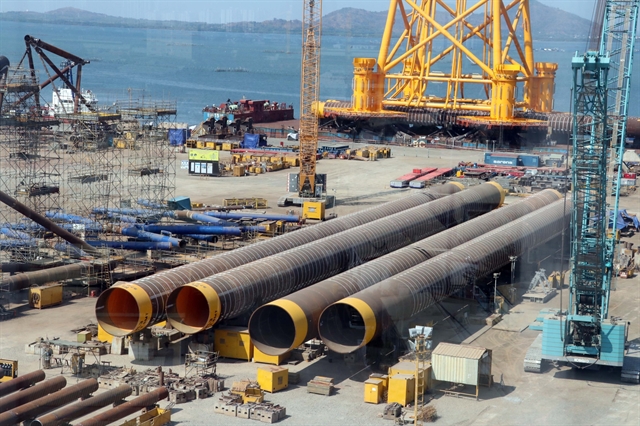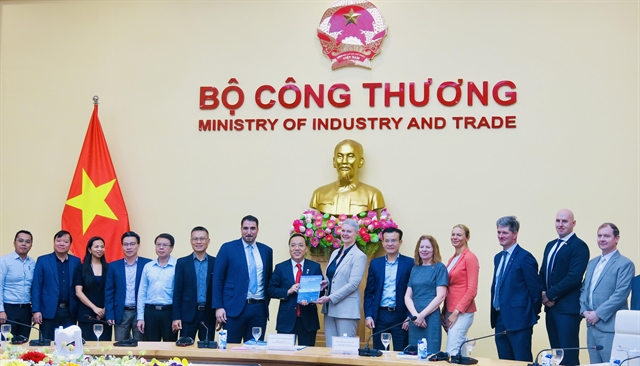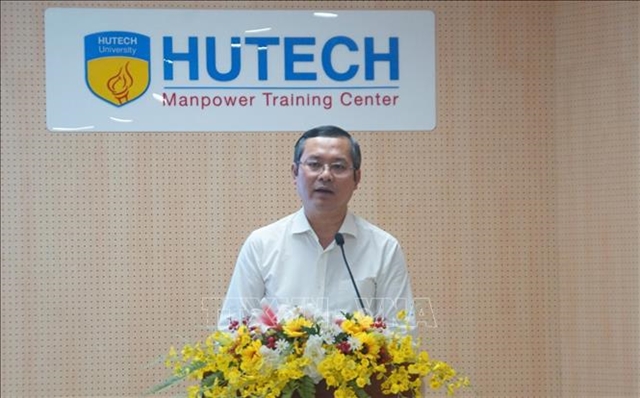 Environment
Environment

 |
| Part of the offshore wind power foundation is being constructed by PetroVietNam Technical Services Corporation (PTSC) at a port in the southern province of Bà Rịa - Vũng Tàu. — VNA/VNS Photo Mạnh Dương |
Nguyễn Hằng
HÀ NỘI — Việt Nam stands poised to take a leading role in the development of offshore wind supply chains in the region, particularly as the supply chain for offshore wind development remains limited in neighbouring countries.
The opportunity arises from Việt Nam's significant offshore wind potential, estimated at around 600GW.
The country benefits from world-class wind resources at 9–14m/s in the south-central region and 7–10m/s in the north region, a coastline exceeding 3,000km with stable high wind speeds, and extensive areas with suitable water depths for fixed seabed foundations.
Việt Nam's transmission network to the coast presents excellent conditions for offshore wind development.
In addition, the country’s strategic position in the Asia-Pacific region, along with high maritime traffic and established port infrastructure, positions it to become a logistics hub for offshore wind components.
The country has valuable experience in the oil and gas sector, as well as onshore and nearshore wind development, which could support offshore wind projects through the provision of essential components and services.
The existing port infrastructure also provides a competitive edge compared to other countries in the region.
The insights were drawn from the report Offshore wind supply chain for fast-track scenario in Việt Nam, co-released on Friday by the Ministry of Industry and Trade and the Norwegian Embassy in Hà Nội.
Ricardo Felici, a consultant for the Norwegian Embassy, who presented the report at the event, said Việt Nam currently had a strong foundation for developing its offshore wind supply chain.
He attributed that to the oil and gas industry, which had significantly contributed to the development of Việt Nam’s supply chain infrastructure for producing foundations, towers, and marine infrastructure.
He further noted that the offshore wind sector had substantial potential to generate significant domestic full-time equivalent (FTE) jobs, particularly during the construction phase.
The offshore wind industry could create up to 9,000 jobs in a scenario where 1GW of offshore wind was developed, and more than 55,000 jobs in a scenario of 6 GW of development, encompassing direct, indirect and induced employment.
He also said that Việt Nam's current efforts to develop offshore wind had received commendations.
The report, commissioned by the Norwegian Embassy in Hà Nội in December 2023, outlines the necessary steps to establish a well-functioning supply chain for Việt Nam’s emerging offshore wind industry.
As for the two pilot projects for offshore wind decided by the Government of Việt Nam, the report illustrates the potential supply chain for the development of 1GW in the north and 1GW in the south (1GW completed for commercial operation by 2030 and an additional 1GW for commercial operation by 2035).
According to the report, Việt Nam also has significant potential to localise key components of an offshore wind project. It also assessed the port infrastructure in both the northern and southern regions and evaluates the readiness of domestic suppliers.
Valuable report
 |
| Deputy Minister of Industry and Trade Nguyễn Hoàng Long (centre left) and Norwegian Ambassador to Việt Nam Hilde Solbakken (centre right) at the event on Friday in Hà Nội.— VNS Photo Nguyễn Hằng |
Talking to local medial on the sidelines of the event, Deputy Minister of Industry and Trade Nguyễn Hoàng Long said: “The report is both high-quality and detailed.”
He added that the report analysed numerous sectors, enhancing awareness of Việt Nam's vast potential for offshore wind development.
“Given Việt Nam's commitment to achieving net-zero emissions by 2050, the development of offshore wind and renewable energy is both essential and the only viable path to reach this goal,” he said.
Long also outlined five favourable factors for developing offshore wind in Việt Nam.
Việt Nam's offshore wind potential was immense, with international assessments estimating it could reach nearly 600,000MW. The country had a solid industrial manufacturing foundation that could bolster local supply chain development for the offshore wind industry. The country offered competitive cost structures for engaging in offshore wind development.
The country's geographical position was advantageous for developing offshore wind, enabling it to become a regional and global hub for energy production, potentially allowing for exports to neighbouring markets.
“The development of offshore wind and its associated supply chain will not only create offshore projects but also promote green jobs and sustainable value-added activities, contributing to green industrial zones and attracting investment across various sectors,” he said.
That was crucial for advancing Việt Nam's economy and achieving the net-zero emissions goal by 2050.
Attracting investment
According to Long, developing offshore wind required significant capital, however, it allowed for harnessing inexhaustible resources without on-going costs.
While the initial investment may be substantial, the long-term benefits of tapping into Việt Nam's limitless wind resources could render the costs competitive over a 30-year horizon.
“With abundant green energy, Việt Nam is positioned to become increasingly attractive to foreign investors,” he added.
One of the foremost criteria for future production was sustainability, companies producing non-green products would face substantial carbon taxes.
Major markets were implementing taxes on non-compliant products, meaning that access to green electricity would enhance Việt Nam's appeal as an investment destination.
Norway's experience
Long indicated that Norway leads the way globally in offshore wind development, benefitting from substantial wind potential and a robust maritime and oil industry.
As Norway transitions to investing in offshore wind, it brings considerable experience to the table.
Norway has been a steadfast partner for Việt Nam in green growth and climate change mitigation efforts for many years.
As Việt Nam sets ambitious renewable energy capacity goals and aims for net-zero emissions by 2050, Norway is a key partner in policy consultation and support across various sectors, including energy consumption and offshore wind.
Additionally, major Norwegian corporations are investing in Việt Nam and are keen to engage in the offshore wind supply chain.
For instance, while Equinor (a Norway’s energy company) recently announced a withdrawal from Việt Nam, its representatives at the seminar expressed that with the Vietnamese Government's efforts to establish a legal framework and refine the market, they were open to returning.
Other significant Norwegian enterprises also seek to participate in the supply chain, particularly in shipbuilding.
The offshore wind industry will require numerous vessels for service, construction, and installation of foundations and turbine blades.
“These businesses are eager to increase investments and attract more companies to join the supply chain, demonstrating Norway's commitment to the Vietnamese market,” he said.
Norwegian Ambassador to Việt Nam Hilde Solbakken said it is quite promising to see that there are already orders coming into Việt Nam from international markets for different parts of the offshore wind value chain, including some of the very advanced vessels that need to serve the offshore wind plants.
“I’m very pleased to say there is a Norwegian shipyard bound to build in (Bà Rịa) Vũng Tàu (Province),” she said adding that the reports being launched at the event will assist Việt Nam in designing both the upcoming pilot projects and the full-scale offshore wind initiatives.
“I believe this would also open new cooperation opportunities for Norwegian and Vietnamese companies,” she said.
The report identifies several opportunities and challenges. It highlights Việt Nam’s natural conditions for wind and seabed development, as well as existing infrastructure from the oil and gas sector.
"However, it acknowledges the global offshore wind market's current challenges, particularly financial constraints impacting everyone.
“But, Việt Nam is off to a promising start,” she said.— VNS




